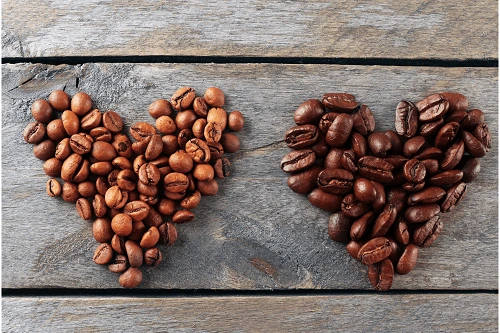Coffee
Which Has More Caffeine Light or Dark Roast Coffee?
Coffee is a beloved beverage that is consumed by millions of people around the world. It provides a much-needed boost of energy and a rich, aromatic flavor that many find irresistible. One question that often arises among coffee enthusiasts is whether there is more caffeine in light or dark roasted coffee. In this article, we will delve into the world of coffee roasting and caffeine content to shed light on this intriguing question.
1. Introduction
Coffee is a complex beverage with various chemical compounds that contribute to its flavor, aroma, and effects on the body. Caffeine, a natural stimulant found in coffee beans, is one such compound. The roasting process plays a significant role in determining the flavor profile of coffee, and it also affects the caffeine content.
2. Understanding coffee roasting
Coffee roasting is a crucial step in the coffee production process. During roasting, green coffee beans are heated to transform them into the aromatic and flavorful beans that we recognize as coffee. The roasting process involves carefully controlling factors such as temperature and duration to achieve the desired roast level.
3. Caffeine content in coffee beans
Coffee beans naturally contain caffeine, a compound that belongs to the class of stimulants known as xanthines. The caffeine content can vary depending on the variety of coffee plant, growing conditions, and other factors. On average, a typical coffee bean contains about 1.1 to 2.2% caffeine by weight.
4. The impact of roasting on caffeine levels
Roasting coffee beans causes various chemical changes within the beans, including the breakdown of certain compounds. One common misconception is that the longer the beans are roasted, the less caffeine they contain. However, the truth is that the roasting process itself does not significantly alter the caffeine content.
5. Caffeine Content in Light roasted coffee
Light roasted coffee is roasted for a shorter duration at lower temperatures compared to dark roasted coffee. It is known for its light brown color and milder flavor profile. Light roasted coffee beans retain more of their original characteristics, including the caffeine content, as they undergo less chemical transformation during roasting.
6. Caffeine Content in Dark roasted coffee
Dark roasted coffee, on the other hand, undergoes a longer roasting duration at higher temperatures. This results in a dark brown to almost black appearance and a bolder, more robust flavor. Dark roasted beans may appear to have less caffeine due to their stronger taste, but the caffeine content remains relatively similar to that of light roasted beans.
7. Comparing caffeine content in light and dark roasted coffee
When comparing the caffeine content of light and dark roasted coffee, it’s important to note that any differences are minimal. While the roasting process does affect the flavor and aroma of the coffee, it does not significantly impact the overall caffeine levels. Therefore, the caffeine content in both light and dark roasted coffee remains relatively similar.
8. Factors influencing caffeine levels
Although the roasting process itself doesn’t dramatically affect caffeine levels, other factors can influence the final caffeine content in a cup of coffee. The brewing method, grind size, water temperature, and extraction time all play a role in the amount of caffeine extracted from the coffee grounds and transferred into the brewed cup.
9. Brewing methods and caffeine extraction
Different brewing methods extract varying amounts of caffeine from the coffee grounds. For example, espresso typically contains more caffeine per ounce compared to drip coffee due to the shorter extraction time and higher pressure used in the brewing process. However, the total caffeine intake can still vary depending on the serving size and the number of espresso shots consumed.
10. The effects of caffeine Content on the body
Caffeine is a stimulant that affects the central nervous system, providing a temporary increase in alertness and reducing the feeling of fatigue. It can improve focus, enhance physical performance, and elevate mood. However, individual responses to caffeine can vary, and some people may experience side effects such as jitters, increased heart rate, or difficulty sleeping.
11. Decaffeinated coffee options
For those who prefer to limit their caffeine intake or are sensitive to its effects, decaffeinated coffee is a popular choice. Decaffeinated coffee goes through a process to remove most of the caffeine while preserving the flavor. However, it’s essential to note that decaf coffee still contains a small amount of caffeine, usually ranging from 0 to 7 mg per 8-ounce cup.
12. The preference factor
The choice between light and dark roasted coffee ultimately comes down to personal preference. Each roast level offers a distinct flavor profile and aroma, which can appeal to different tastes. Some individuals may enjoy the bright acidity and floral notes of light roasted coffee, while others prefer the bittersweet and smoky flavors of dark roasted coffee.
13. The myth of caffeine burn-off
Contrary to a popular misconception, it does not “burn off” during the roasting process. While some volatile compounds are lost during roasting, caffeine remains relatively stable. Therefore, choosing a lighter roast does not necessarily result in a significantly higher caffeine content compared to a darker roast.
14. Is there a health difference between light and dark roasted coffee?
In terms of health benefits, both light and dark roasted coffee offer similar advantages. Coffee contains antioxidants and may contribute to reduced risk of certain conditions such as type 2 diabetes, Parkinson’s disease, and liver disease. However, it’s important to consume coffee in moderation and consider individual sensitivities or health conditions.
15. Conclusion
When it comes to the caffeine content of coffee, the difference between light and dark roasted beans is minimal. The roasting process itself does not significantly alter the caffeine levels, and any variations in taste or perceived caffeine strength are primarily due to flavor and aroma differences. Ultimately, the choice between light and dark roasted coffee should be based on personal preference and desired flavor characteristics.
FAQs (Frequently Asked Questions)
Q1: Does light roasted coffee have more caffeine content than dark roasted coffee?
A1: No, the difference in caffeine content between light and dark roasted coffee is negligible. Both roast levels contain a similar amount of caffeine.
Q2: Can I get a stronger caffeine kick from dark roasted coffee?
A2: While dark roasted coffee may have a bolder flavor, it does not necessarily provide a stronger caffeine kick compared to light roasted coffee.
Q3: Does decaf coffee contain no caffeine at all?
A3: Decaffeinated coffee still contains a small amount of caffeine, typically ranging from 0 to 7 mg per 8-ounce cup.
Q4: What brewing method extracts the most caffeine content?
A4: Espresso brewing methods tend to extract more caffeine per ounce compared to other brewing methods, such as drip coffee.
Q5: Should I choose light or dark roasted coffee for health benefits?
A5: Both light and dark roasted coffee offer similar health benefits. The choice should be based on personal preference rather than health differences.

